The crane mutiny: how Sydney's apartment boom spun out of control
Building apartments along transport routes in Sydney was meant to create a more sustainable city. But only developers seem happy with the results
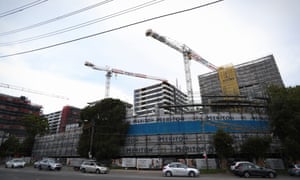
Reserve Bank figures show 78,000 new units were approved between 2012 and 2015, an increase of 18% on existing apartment stock. Photograph: Mike Bowers for the Guardian
Mike Ticher
Wed 3 Jan ‘18 13.00 ESTLast modified on Wed 3 Jan ‘18 13.01 EST
Across the road, a giant crane has been working on a new block of apartments on the site of a former service station. Another is going up down the road, where the bank used to be. More units are planned for the local RSL site and for two factories within a few hundred metres, and on dozens of other sites in my inner-western Sydney suburb that were previously industrial buildings, commercial premises, car parks or waste ground.
Go a bit further afield and the pace of medium- and high-density redevelopment is mind-boggling. Across Sydney’s inner and middle-ring suburbs, from Rockdale and Wolli Creek in the south, through the inner west, out to Parramatta, up to Ryde and on to the suburbs along the north shore train line, the city is changing before our eyes.
All Australia’s state capitals have seen versions of the same phenomenon but the pace and scale of change in Sydney is exceptional. On the face of it, creating more densely populated neighbourhoods along existing transport corridors makes perfect sense – it has been the policy of successive state governments for the best part of 30 years, in various guises. The downsides of encouraging the city to sprawl across an ever larger area are obvious. Bringing more people within reach of the city, with greater density around local hubs, should in theory be more environmentally sustainable, reduce car dependence, alleviate property price pressures and help create the diverse, vibrant neighbourhoods most residents want.

Sign up for Guardian Today Australian edition: the stories you need to read, in one handy email
Read more
But that theory is not working out.
A poll published in Fairfax Media in October found 66.4% of residents agreed that Sydney was “full” and development should be pushed outside the metro area. Across the suburbs, local groups are fiercely resisting plans for more building. In the south the proposed development of the Sydenham-to-Bankstown rail corridor has become a lightning rod for discontent. A plan to build 2,600 units in towers of up to 28 storeys in the inner west has run into outraged opposition under the slogan “Marrickville, not Mirvacville”. In October an even larger proposed development at Rhodes East, on the Parramatta river, was savaged by the local Liberal state MP, John Sidoti, who said some of what was proposed was “just plain wrong”.
It seems nothing can stop the building, short of an economic downturn. But how have governments failed so dismally to persuade Sydneysiders of the benefits of higher-density living? And is it too late to rescue the benefits of a more compact, less car dependent, more sustainable city?
The density push
Australian cities have long been among the least dense in the world. According to weighted calculations by the blog chartingtransport.com, Sydney had a density of 36 people for every hectare in 2011, compared with 80 in London, 133 in Paris and an astonishing 246 in Barcelona. No one wants Sydney to emulate the less attractive features of the most tightly packed European cities (lack of green space, for example) but there has been a consensus among planners and politicians at least since the 1980s that increasing density in established suburbs makes much more sense than continuing to expand outwards.
Planning is only one factor behind the apartment-building boom. Years of low interest rates and the incentives for investing provided by negative gearing and capital gains tax arrangements underpin every aspect of the Australian property market. But in Sydney successive state governments have encouraged the rezoning of industrial and commercial sites near transport routes, and since 2014 the New South Wales Department of Planning and Environment has identified “priority precincts” for high-density development – 28 at the last count – described as having “good access to existing or planned public transport connections” and “suitable for rejuvenation with new homes and jobs”.
Figures from the Australian Bureau of Statistics show monthly building approvals for apartments in Sydney topped 3,000 for the first time in September 2013, then 4,000 in December 2014 and 5,000 in July 2016, before falling off last year. That meant 78,000 units were approved between 2012 and 2015, RBA figures show, an increase of 18% on the existing apartment stock. In November 2016 the then planning minister, Rob Stokes, announced plans for a further 184,000 homes by 2021, to win “the war against sprawl” with “a real focus on apartments, on terrace houses and on medium-density developments in established areas”.
As a result, by the end of last year, more than 350 cranes were at work in Sydney, more than half of the total in the whole of Australia, of which 85% were involved in residential construction. And in contrast to other Australian cities, they are spread throughout the suburbs rather than concentrating in the central business district. In 2016, for the first time, more apartments than houses were built in Australia, and Sydney, where flats now account for 28% of housing, is well ahead of the average.
The community protest
Public hostility to increasing density comes in many forms and is far from uniform. Research by the Centre for Urban Transitions at Swinburne Universitysuggests that residents of established inner and middle suburbs in both Sydney and Melbourne have “a growing capacity to accept change but at present it is grudging and not strongly endorsed”.
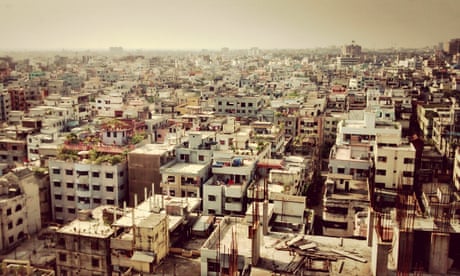
Where is the world's densest city?
Read more
Some grounds for that unhappiness are obvious. Higher density development has not yet fulfilled the hopes of those who claim lack of supply is the key to taming rampant property prices, despite recent signs of the market weakening. But it has contributed to ever greater inequality, according to three reports produced last year for Shelter by the City Futures Research Centre at the University of NSW.
The quality of construction is a further concern. In 2015 Engineers Australia warned that the building system in NSW had “broken down” and a major incident was inevitable as units were being built by developers who were “totally inexperienced”. Hazel Easthope, a senior research fellow at the City Futures centre, says her research has uncovered “an incredibly high incidence of building defects”, including fire safety non-compliance, major leaks and structural cracking in new buildings.
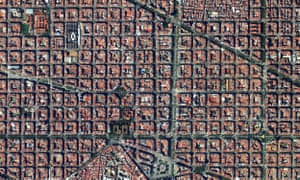
FacebookTwitterPinterest The Eixample district in Barcelona, Spain, is characterised by its strict grid pattern, octagonal intersections and apartments with communal courtyards. Photograph: Daily Overview/DigitalGlobe/REX Shutterstock
But emotions run highest over more existential questions about what higher densities are doing to indefinable qualities such as the “character” of suburbs, and the stresses brought by a dramatic influx of residents without a corresponding expansion of services.
In December the premier, Gladys Berejiklian, told Fairfax she wanted the best of all worlds.
“I for one … don’t want communities to lose their local character,” she said. “I want people to feel they are living in good urban environments with greenery and green space. But also we have to look at opportunities where we can increase supply. People do want to downsize, upsize, have choice of housing.”
Sometimes that circle simply cannot be squared. There is a tension here that to some extent mirrors the broader housing divide between baby boomer property owners and those locked out of the market. Campaigners against development – particularly those arguing for the preservation of “heritage” in leafy suburbs where freestanding houses command astronomical prices – inevitably leave themselves open to the charge that they simply want higher densities pushed into poorer and more distant areas.
In July the chief executive of the Committee for Sydney, Tim Williams, accused north shore residents of “high-octane nimbyism” in rejecting plans for more housing. And some opposition to development has been explicitly hostile to greater density under any circumstances.
On the northern beaches, an unlikely coalition of the former Labor premier Barrie Unsworth and the former federal Liberal MP Bronwyn Bishop held forth at a public meeting last April about the threats to the beaches lifestyle, Fairfax reported. “High-density living is what most people who live here have come to escape,” Bishop told the meeting. Unsworth attacked the controversial new B-Line bus service along the peninsula – not for its deficiencies as a transport project but as “a Trojan horse” for development.
But most opponents of the current strategy vehemently deny they are against densification in itself.
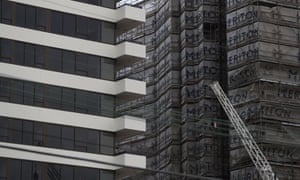
FacebookTwitterPinterest The Greens fear ‘block after block of cookie-cutter apartment blocks’ will fill the horizon. Photograph: Mike Bowers for the Guardian
The Sydenham to Bankstown Alliance highlights the threat to the character of suburbs such as Hurlstone Park and Dulwich Hill from the priority precinct plans associated with construction of the metro line that is scheduled to replace the train line from Sydenham to Bankstown, eventually linking the south-west suburbs with Chatswood on the north shore.
“The level and scale of development proposed is random, arbitrary and brutal in its approach, resulting in suburbs that will be left with little of the charm, heritage and character which attracted residents to the area in the first place,” the alliance’s website says.
Its spokesman, the former Marrickville Greens councillor Peter Olive, says defence of heritage is only part of the alliance’s case.
“I don’t think that’s overly controversial or a sign necessarily of nimbyism, it’s just saying there are historical buildings here that need to be preserved, historical streetscapes, townships, villages if you like, that should be given some sort of greater consideration rather than having the broad brush of a 400-metre or 800-metre radius circle drawn over it for densification.”
He cites the “very strong reservations” of the fomer administrators of both the Inner West council and Canterbury-Bankstown council (appointed after the government forcibly merged elected local councils), who pointed to shortfalls in open space, impacts on local traffic and inadequate provisions for schools and healthcare in the plans.
“Neither of those two persons are nimbys – they are both state government appointees,” Olive says.
It is the failure to provide infrastructure and services to keep pace with population growth that has really fuelled public discontent, says Hazel Easthope of the City Futures Research Centre.
“One of the things that makes me mad is when I hear people saying in the media, ‘This is just nimbys who don’t want apartments in their area,’” Easthope says.
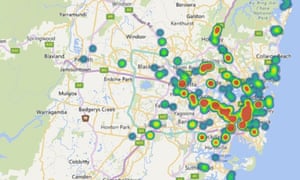 A heatmap of cranes in Sydney in the fourth quarter of 2017. Photograph: Rider Levett Bucknall
A heatmap of cranes in Sydney in the fourth quarter of 2017. Photograph: Rider Levett BucknallShe believes many people would accept more density if it meant they also got more frequent transport services, more school places, a better choice of shops and services and improved housing affordability.
“That’s pretty much the narrative we’re getting. It’s not that people are saying they’re against density. It’s that they don’t believe that all the things they’ve been told are going to come with it are actually going to come with it.”
Corinne Fisher represents the Better Planning Network, an umbrella group for more than 400 local organisations. She says hostility to development stems ultimately from “a complete failure of process” in consulting residents before large projects are announced.
“If you’re going to ask people to accept, in the case of the Sydenham to Bankstown corridor, tens of thousands of new homes, then you need to come out upfront with a financial commitment for the … infrastructure that you are going to contribute to this development. And that really hasn’t happened anywhere.
“Densification can be done well … but you need to respect what people are telling you they love about their neighbourhood and to work with them to protect these features. And that may be that you don’t build so high. At the moment, the people driving the developments, and the heights of the units within any particular precinct, they are not the residents, they’re the developers. There is only one category of people driving the government’s decision making.”
The planning minister, Anthony Roberts, denies that claim, saying collaboration with local councils and early engagement with the community is a “fundamental element” of the planned precincts program.
“This ensures a planned approach to creating new homes and jobs located close to public transport, shops and services, while retaining and enhancing local character.”
Roberts cites the provision of 2.4 hectares of open space and a commitment of $22m in transport upgrades to support redevelopment around North Ryde station as an example of the government’s response to community consultation.
But both Easthope and Fisher say the government has relaxed its control of the densification strategy.
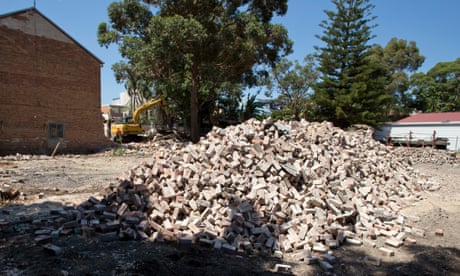
WestConnex: bitter battles mark the road to Australia's urban future
Read more
“If you look back at the 2005 metropolitan strategy, it was quite prescriptive about where the new development would occur,” Easthope says. “And then it didn’t occur in those locations – because the market didn’t support development in those areas. And then if you look at the 2014 metropolitan strategy, it’s much more pragmatic about the fact that delivery of apartments is largely market-led.”
Fisher blames wholesale rezoning and the “outrageous” ad hoc nature of the precinct designations for undermining the Greater Sydney Commission, the body that is meant to coordinate planning for the city.
“The public has no idea how the government is coming to these decisions and they also have no input as to where those priority precincts appear – suddenly there’s an announcement and, the next thing you know, they’re slapped with a proposal for thousands of new homes in their neighbourhood,” Fisher says. “And they basically have to accept the situation.
“It’s farcical, because the Greater Sydney Commission can’t keep up with the announcements.”
The commission declined to comment.
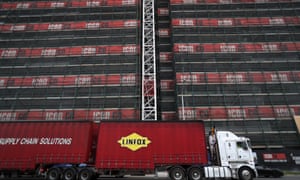
FacebookTwitterPinterest A poll found 66.4% of residents agreed that Sydney was ‘full’ and development should be pushed outside the metro area. Photograph: Mike Bowers for the Guardian
Winds of change?
Politically, the winds are blowing against the pace and scale of development. Labor has promised to tear up the precincts plan if it wins the next state election, due in March 2019. The party positioned itself strongly against “over-development” in Kristina Keneally’s campaign for the federal seat of Bennelong, which covers middle-ring suburbs in the north-west. At the launch of her byelection campaign with Bill Shorten, Keneally twice referred to the Liberal state government having “presided over thousands of unit developments in this area”.
As well as Sidoti, at least three Liberal MPs have expressed unhappiness at developments planned for their electorates. David Elliott, the member for Baulkham Hills in north-west Sydney, was so agitated by the plan for 8,200 new homes in Bella Vista and Castle Hill that he admitted using “unparliamentary terms” while making his case to the planning minister.
And the Greens have been at the forefront of opposition to many proposals for greater density. In a statement their NSW planning spokesman, David Shoebridge, painted an apocalyptic picture of the city’s future if present trends continued.
“Soon cranes litter the skyline, trees are lost and block after block of cookie-cutter apartment blocks fill the horizons. There’ll be no investment in public infrastructure like schools, green space and public transport. There’ll be no place for kids to play, for people to exercise. You won’t be able to get a seat on the train, schools will be so overcrowded they’ll have to stagger play times.”
I think we’ll see some changes as the 2019 elections get closerCorinne Fisher
Whether discontent will translate into more policy changes may become clearer as the election approaches. There are some straws in the wind, such as announcements that new schools will be built to accommodate the growing populations in Ultimo, Surry Hills and Green Square, which will become Sydney’s most densely populated suburb when the massive apartment complexes built there are filled. The huge unmet demand for schools was “essentially the result of assumptions on the part of state government that families with children wouldn’t live in apartments”, Easthope says. “Which were incorrect.”
Olive says the election is the only realistic chance to halt the current strategy and move towards a plan for rail corridors that do not simply duplicate the pattern that brings all lines into the city.
“There needs to be a direct link between any priority planning precinct and new rail lines, services and corridors. The emphasis is on the new – not conversions … If they want to densify a suburb, they need to link it by new rail services, that’s the crucial nexus between a 30-minute city and planning.”
Corinne Fisher says the government will be under increasing pressure to take the heat out of the protests by addressing the infrastructure deficit, particularly in light of its budget surplus and willingness to spend more than $2bn to knock down and rebuild Allianz and ANZ stadiums.
“I think we’ll see some changes as the 2019 elections get closer,” Fisher says. “There’s absolutely no doubt that [overdevelopment] will be a major election issue and the NSW government has lost an incredible amount of credibility and trust among communities. It will have to address this issue. If it doesn’t, I would say that would have a very big impact on how people will vote.”
No comments:
Post a Comment